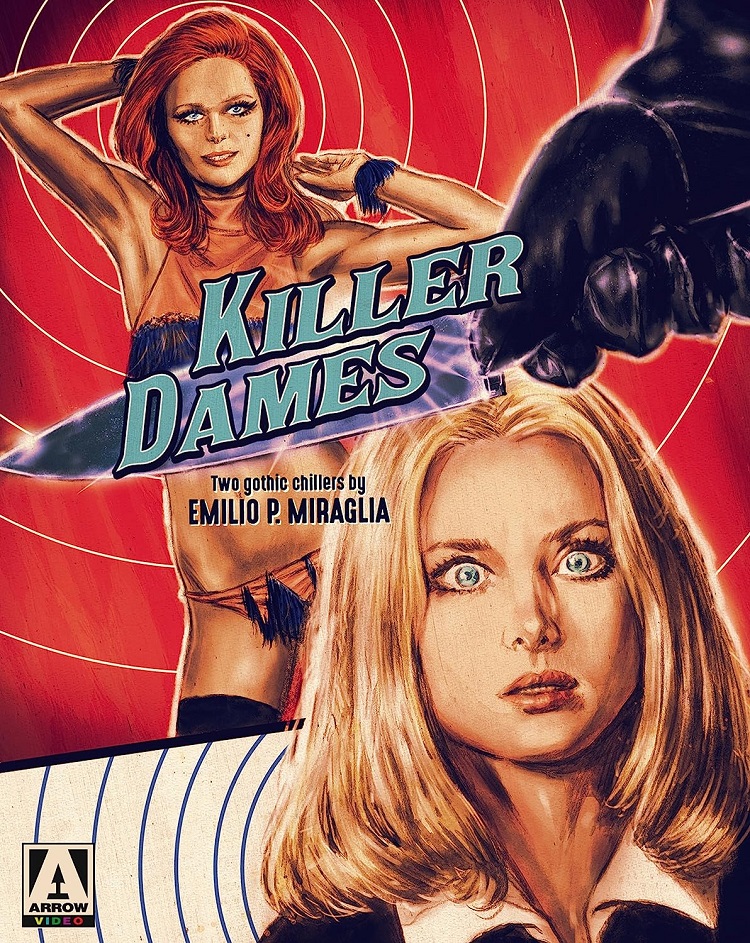
Emilio Miraglia rose through the ranks of Italian cinema in the early ’60s, making his bones as an assistant director on over 15 films before taking the reins as director. After a couple of mostly forgotten action flicks and a heist picture, he made two well regarded (at least among genre fans) giallos before turning to the Spaghetti Western genre. He directed six films between 1967 and 1972 and then completely disappeared from cinema all together.
It’s the giallos he is remembered for and Arrow Video has put the pair together in another of their fantastic, limited edition releases. A casual glance at those six films one might expect that he was a hack, moving from one genre to the next trying desperately to catch the newest wave of popular films. But after watching these two gothic horror films (The Night Evelyn Came Out of the Grave and The Lady In Red Kills Seven Times), one feels a great loss wondering what he could have made had he stuck around. Produced in 1971 and 1972 respectively, these two films came out right at the height of the giallo craze which is likely why they are not better known outside (and even inside to a lesser extent) of genre circles.
The Night Evelyn Came Out of the Grave concerns Alan (Anthony Steffen), a wealthy aristocrat who overcomes the death of his wife (the Evelyn of the title) by bringing red-headed prostitutes to his gothic castle and brutally torturing them. He marries Gladys (Marina Malfatti) only one day after meeting her (she’s another redheaded stripper who gets one of the greatest entrances of any giallo – performing a strip-tease act straight out of a coffin). The hope is that by marrying someone who looks a bit like Evelyn his psychopathic tendencies will stop. They don’t, of course, and his violence only escalates when Evelyn turns up missing from her grave and is possibly wandering about scaring him half to death.
The castle makes for an interesting setting. On the outside and in many of the interior rooms, it is your classic gothic castle with its high arches, deep shadows, and general creepiness embedded with cobwebs. But after a certain point, the rooms become very modern (or modern for the early ’70s) with loudly colored cushions, plush beds, and everything a swinging dude needs. Just past that lies the kinky dungeon with its eclectic variety of kinky torture devices.
Which, in a lot of ways, really sets up the style and themes of the film. It is very much a gothic horror mixed with modern giallo references. You’ve got the haunted castle, ghostly creatures lurking about, and there’s even a bit about an inheritance. On the giallo side, there is the black-gloved killer, some wild and interesting deaths, and a plot that twists and turns but makes very little sense. It’s loaded with style (and blood and nudity). It doesn’t have quite the electric verve as the best films by Argento, but it’s a fun ride all the same.
The Red Queen Kills Seven Times is probably the better film, but it’s not nearly as entertaining. In the opening prologue, we learn the cursed history of two sisters, Kitty and Evelyn. Their ancestors unleashed a deadly curse when one of them killed seven times and now every 100 years someone in the family kills again.
Flash forward to 1972 to the 100-year anniversary and we find ourselves back with Kitty (Barbara Bouchet) and a new sister, Franziska (Marina Malfatti). They pretend Evelyn has moved off to America, but in flashbacks we see that Kitty accidentally killed her. Pretty soon a killer all dressed in red shows up, creatively knocking off everyone the sisters care for. Could the killer be Evelyn come back from the grave to haunt them? Has the curse come true?
The plot is pretty convoluted with red herrings galore and big twist after big twist showing up to keep everyone confused. Not that it matters for the film has loads of style and lots of imaginative cinematography. It’s a much better film than The Night Evelyn Came Out of the Grave with a much more interesting visual sense, a tighter script (though it is still impossible to understand), and better acting all around. But it’s missing a bit of that giallo craziness that makes the genre so enjoyable. The action sequences are smartly created but when they slow down to dialogue, some of the plot points sucks all the oxygen out of the film.
I wouldn’t rate either of these films at the top of my Italian Horror list, but both are well worth watching.
Arrow has once again knocked it out of the park. The audio and video have been remastered from the original sources and they look and sound great. Both films come with audio commentaries, recent interviews with the stars of the films (my favorite of which is with Sybil Danning who spends most of her talk explaining why her numerous nude scenes were perfectly justified). Both also contain discussions with critic Stephen Threwer, various archival features, and interviews. Lastly, this limited-edition set (there were only 3,000 printed) comes with a beautiful book filled with essays.
If you are new to Italian Horror and the gothic giallo genres, I can’t say that I’d start with these two films, but after you’ve caught up with the masters (Dario Argento, Mario Brava, Lucio Fulci), this release is an excellent place to continue your education.